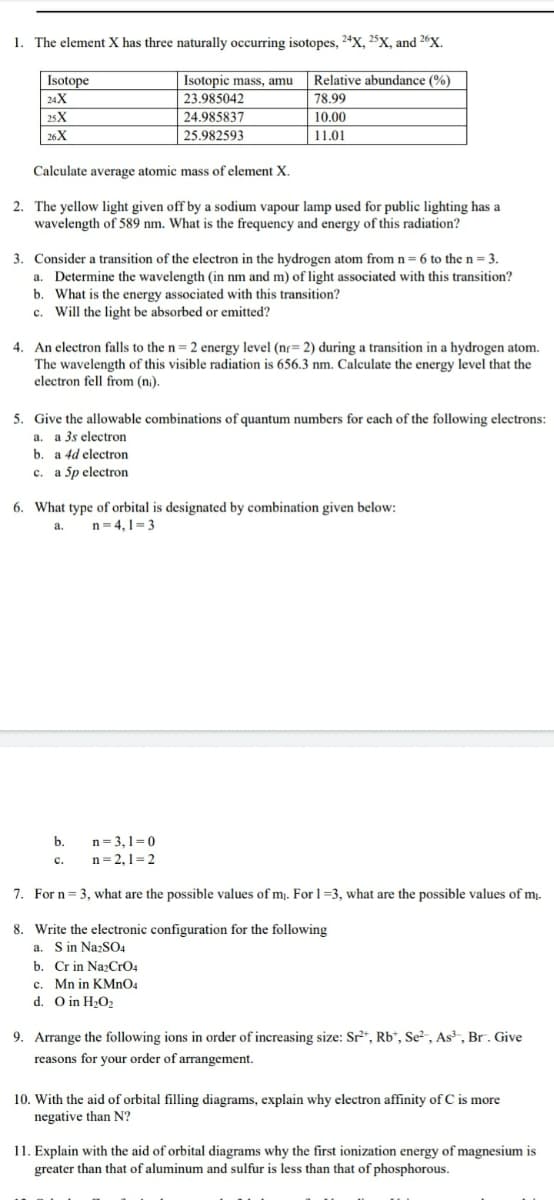1. The element X has three naturally occurring isotopes, 24X, 25X, and 2%X. Isotope 24X Isotopic mass, amu Relative abundance (%) 78.99 10.00 23.985042 25X 24.985837 26X 25.982593 11.01 Calculate average atomic mass of element X.
1. The element X has three naturally occurring isotopes, 24X, 25X, and 2%X. Isotope 24X Isotopic mass, amu Relative abundance (%) 78.99 10.00 23.985042 25X 24.985837 26X 25.982593 11.01 Calculate average atomic mass of element X.
Chemistry: An Atoms First Approach
2nd Edition
ISBN:9781305079243
Author:Steven S. Zumdahl, Susan A. Zumdahl
Publisher:Steven S. Zumdahl, Susan A. Zumdahl
Chapter5: Stoichiometry
Section: Chapter Questions
Problem 23Q: Reference Section 5-2 to find the atomic masses of 12C and 13C, the relative abundance of 12C and...
Related questions
Question
Please help

Transcribed Image Text:1. The element X has three naturally occurring isotopes, 24X, 25X, and 26X.
Isotope
Isotopic mass, amu
Relative abundance (%)
24X
23.985042
78.99
25X
24.985837
10.00
| 26X
25.982593
11.01
Calculate average atomic mass of element X.
2. The yellow light given off by a sodium vapour lamp used for public lighting has a
wavelength of 589 nm. What is the frequency and energy of this radiation?
3. Consider a transition of the electron in the hydrogen atom from n= 6 to the n = 3.
a. Determine the wavelength (in nm and m) of light associated with this transition?
b. What is the energy associated with this transition?
c. Will the light be absorbed or emitted?
4. An electron falls to the n= 2 energy level (nr= 2) during a transition in a hydrogen atom.
The wavelength of this visible radiation is 656.3 nm. Calculate the energy level that the
electron fell from (ni).
5. Give the allowable combinations of quantum numbers for each of the following electrons:
a. a 3s electron
b. a 4d electron
с. а 5pelectron
6. What type of orbital is designated by combination given below:
n = 4, 1= 3
a.
b.
n=3,1=0
с.
n=2,1=2
7. For n = 3, what are the possible values of m. For 1=3, what are the possible values of m.
8. Write the electronic configuration for the following
a. S in NazSO4
b. Cr in NazCrO4
c. Mn in KMNO4
d. O in H2O2
9. Arrange the following ions in order of increasing size: Sr²“, Rb“, Se², As², Br. Give
reasons for your order of arrangement.
10. With the aid of orbital filling diagrams, explain why electron affinity of C is more
negative than N?
11. Explain with the aid of orbital diagrams why the first ionization energy of magnesium is
greater than that of aluminum and sulfur is less than that of phosphorous.
Expert Solution
This question has been solved!
Explore an expertly crafted, step-by-step solution for a thorough understanding of key concepts.
This is a popular solution!
Trending now
This is a popular solution!
Step by step
Solved in 2 steps

Knowledge Booster
Learn more about
Need a deep-dive on the concept behind this application? Look no further. Learn more about this topic, chemistry and related others by exploring similar questions and additional content below.Recommended textbooks for you

Chemistry: An Atoms First Approach
Chemistry
ISBN:
9781305079243
Author:
Steven S. Zumdahl, Susan A. Zumdahl
Publisher:
Cengage Learning

Chemistry by OpenStax (2015-05-04)
Chemistry
ISBN:
9781938168390
Author:
Klaus Theopold, Richard H Langley, Paul Flowers, William R. Robinson, Mark Blaser
Publisher:
OpenStax

Chemistry & Chemical Reactivity
Chemistry
ISBN:
9781133949640
Author:
John C. Kotz, Paul M. Treichel, John Townsend, David Treichel
Publisher:
Cengage Learning

Chemistry: An Atoms First Approach
Chemistry
ISBN:
9781305079243
Author:
Steven S. Zumdahl, Susan A. Zumdahl
Publisher:
Cengage Learning

Chemistry by OpenStax (2015-05-04)
Chemistry
ISBN:
9781938168390
Author:
Klaus Theopold, Richard H Langley, Paul Flowers, William R. Robinson, Mark Blaser
Publisher:
OpenStax

Chemistry & Chemical Reactivity
Chemistry
ISBN:
9781133949640
Author:
John C. Kotz, Paul M. Treichel, John Townsend, David Treichel
Publisher:
Cengage Learning

Chemistry & Chemical Reactivity
Chemistry
ISBN:
9781337399074
Author:
John C. Kotz, Paul M. Treichel, John Townsend, David Treichel
Publisher:
Cengage Learning

Principles of Modern Chemistry
Chemistry
ISBN:
9781305079113
Author:
David W. Oxtoby, H. Pat Gillis, Laurie J. Butler
Publisher:
Cengage Learning

Chemistry: Principles and Practice
Chemistry
ISBN:
9780534420123
Author:
Daniel L. Reger, Scott R. Goode, David W. Ball, Edward Mercer
Publisher:
Cengage Learning